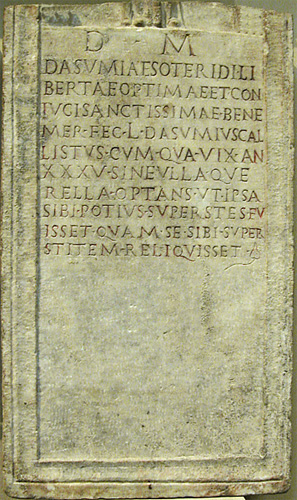
Marble funerary stele, Rome, 2 century CE

This monument was dedicated to Dasumia Soteris by her husband, Lucius Dasumius Calistus. The upper part of the stele once contained a relief carving, now destroyed; judging from the drapery surrounding the two feet visible above the Dˑ M of the inscription, the central figure was a standing woman, probably Dasumia herself. The fact that Soteris has the same nomen as her husband suggests that they may have been fellow-slaves who were freed by the same master (see names of freedpersons). However, Calistus addresses Soteris as liberta, a term used by a patron toward his/her freedperson, making it clear that Soteris had been his slave whom he had freed in order to contract a legal marriage with her and produce citizen children who would be his heirs. Using language that is conventional funerary praise (optima, sanctissima, benemerens, sine querella), Calistus concludes with an elegantly expressed wish that he had died before Soteris. The size of the monument, the skillfully carved letters, and the length of the text are a good indication of Calistus' prosperity and his dedication to his long-time marriage partner. The letters are deeply cut square capitals, carefully spaced; some still bear the traces of red paint. Most of the words are separated by interpuncts (medial dots); many words are split at the end of the line (see the CIL transcription below; the text reproduces the whole word for ease of translation). The end of the epitaph is marked by a decorative ivy leaf; such marks (called hederae distinguentes) are found frequently on funeral monuments, but also on imperial decrees. Here, the heart-shaped ivy leaf may be symbolic of affection or of a wish for continued life, through association with the perennial plant or with the god Dionysus. Calistus, expecting perhaps to be buried with Soteris, may have left the lower half of the stele blank for his own epitaph; had he died without heirs and intestate, his property and the responsibility for his burial would have devolved upon his former master, who apparently did not bury Calistus with his wife. The monument was discovered in 1616 CE in a field near St. John at the Porta Latina.
LIBERTAE OPTIMAE ˑ ET ˑ
CONIVGI SANCTISSIMAE ˑ BENEMER[enti]ˑ
5 FEC[it] ˑ L[ucius] ˑ DASVMIVS CALISTVS ˑ
CVM ˑ QVA ˑ VIX[it]ˑ AN[nis]
OPTANS ˑ VT ˑ IPSA
SIBI ˑ POTIVS ˑ SVPERSTES ˑ FVISSETˑ
10QVAM ˑ SEˑ SIBI ˑ SVPERSTITEM ˑ
Click on the underlined words for translation aids and commentary, which will appear in a small window.